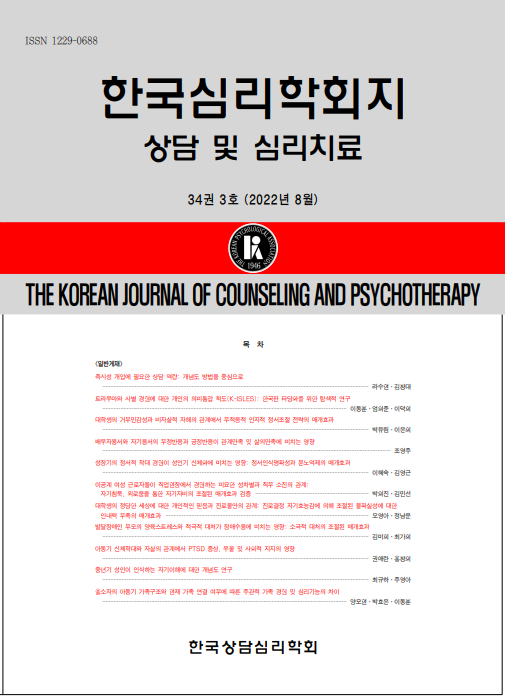open access
메뉴
open access
메뉴 ISSN : 1229-0688
ISSN : 1229-0688
본 연구는 대학생의 애착유형, 부모․또래 애착 그리고 정서인식․표현과의 관계를 알아보고자 하였다. 서울, 경기 지역의 대학생 308명을 연구대상으로 하였다. 측정도구는 Bartholomew 와 Horowitz(1991)의 애착유형 척도, Armsden 과 Greenberg(1987)의 부모․또래 애착 척도 개정판(Inventory of Parent and Peer Attachment-Revised version: IPPA-R), Salovey, Mayer, Goleman, Turvey 및 Palfai(1995)의 특질상위기분척도, King 과 Emmons(1990)의 정서표현질문지를 사용하였다. 연구 결과는 다음과 같다. 첫째, 애착유형에 따라 부모로부터의 소외감, 또래와의 의사소통 및 상호신뢰, 그리고 또래로부터의 소외감에 유의미한 차이가 있었다. 둘째, 안정형은 몰두형 및 공포형과 정서인식에 있어 유의미한 차이를 보였으며, 거부형과는 정서표현에 있어 유의미한 차이를 보였다. 셋째, 거부형, 몰두형, 그리고 공포형의 또래애착은 정서인식 및 표현과 유의미한 상관관계가 있었다. 반면, 거부형의 부모애착은 정서표현과 유의미한 상관관계가 있었고, 몰두형의 부모애착은 정서인식과 유의미한 상관관계가 있었다. 이상의 연구결과는 대학생을 상담하는데 있어 애착과 정서적 특성을 이해하는데 도움이 될 것이라 기대된다.
The purpose of this study was to examine the relationships among attachment style, parent and peer attachment, emotional awareness, and emotional expressiveness in college students. The participants were 308 college students from Seoul and Kyong-Gi province. The instruments included: (a) Attachment Style (Bartholomew & Horowitz, 1991), (b) Inventory of Parent and Peer Attachment - Revised Version (Armsden & Greenberg, 1987), (c) Trait Meta-Mood Scale (Salovey, Mayer, Goleman, Turvey & Palfai, 1995), and (d) Emotional Expressiveness Questionnaire (King & Emmons, 1990). The results were as follows. First, there were significant differences in the alienation from parent, trust with peer, communication with peer, and alienation from peer on attachment style. Second, secure attachment style showed significant differences from both preoccupied attachment style and fearful attachment style on emotional awareness, and secure attachment style showed a significant difference from dismissing attachment style on emotional expressiveness. Third, peer attachment of dismissing attachment style, preoccupied attachment style, and fearful attachment style was correlated with emotional awareness and expressiveness. On the other hand, dismissing attachment style's parental attachment was correlated with emotional expressiveness and preoccupied attachment style's parental attachment was correlated with emotional awareness. The study findings help counselors to better understand attachment and emotional characteristics in college students.
(1997) 한국 대학생의 애착 유형 분포와 대인관계 특성,
(1998) 정서주의력정서인식의 명확성 부정적 기분조절 기대치가 도움추구 행동에 미치는 영향,
(2002) 부모의 양육태도 및 정서표현성과 자녀의 정서지능과의 관계,
(2001) 억압적 성격 성향자의 정서적 특성과 정서조절 방략,
(1998) 청소년기 애착 안정성과 우울성향의 관계,
(1997) Trait Meta-Mood Scale의 타당화에 관한 연구 정서지능의 하위 요인에 대한 탐색 사회 및 성격,
(1998) 청년기와 정서, 학문사
(1997) 청소년기의 애착과 자아존중감 및 자기효능간의 관계,
(1998) 발달정신병리학의 이해, 학지사
(1997) 정서표현성이 건강 및 주관적 안녕에 미치는 영향,
(1978) Patterns of attachment A psychological study of the strange situation,
(1994) Autonomy and relatedness in family interactions as predictors of expressions of negative adolescent affect Journal of Research on Adolescence,
(1999) Attachment in adolescence , Guilford Press
(1987) The inventory of parent and peer attachment:Individual differences and their relationship to psychological well-being in adolescence,
(1991) Attachment styles among young adults:A test of a four-category model,
(1958) The nature of the child's tie to his mother,
(1995) Dimensions of attachment,
(1997) Attachment formation and transfer in young adults' close friendships and romantic relationships,
(2001) Primary attachment to parents and peer during adolescence:Differences by attachment style,
(1987) Romantic love conceptualized as an attachment process,
(1999) Interpersonal attachment: Experiencing, Expressing, and coping with stress, Expressing
(1990) Conflict over emotional expression:Psychological and physical correlates,
(2000) Emotional openness as a predictor of college students' attitude toward seeking psychological help Journal of Counseling Psychology,
(1992) and late adolescent' comparisons of the functional importance of five significant relationships Journal of Youth and Adolescence,
(1990) Parents' unresolved traumatic experiences are related to infant disorganized attachment status Is frightened and/or frightening parental behavior the linking mechanism? In M Attachment in the preschool years University of Chicago Press,
(1985) Security in infancy A move to the level of representation Growing points of attachment theory and research Monographs of the Society for Research in Child Development,
(1986) Discovery of a new Affective development in infancy,
(1988) The experience and meta-experience of mood,
(1988) Cognitive domains of the mood system Journal of Personality and Social Psychology,
(1993) The intelligence of emotional intelligence,
(1994) An emerging understanding of the reflective experience of mood Journal of research in personality,
(1994) Parent-child attachment working models and self-esteem in adolescence,
(1998) Adult attachment style and individual differences in functional versus dysfunctional experiences of anger Journal of Personality and Social Psychology, Mikulincer
(1994) Adolescents' perceptions of their attachment relationships with their mothers Journal of Youth and Adolescence,
(1992) Perceived attachments to parents and peers and psychological well-being in adolescence,
(1995) Emotional attention, clarify, and repair: Exploring emotional intelligence using the Trait Meta-Mood Scale.,
(1999) Affective dimensions of attachment styles and emotional experience among college students Journal of Counseling Psychology,
(1997) Romantic jealousy and adult romantic attachment,
(1986) Attachment and the construction of relationships,
(1990) Interdependency in the family and harmony in the parent-adolescent relationship, Harvard University Press
(1986) The vicissitudes of autonomy in early adolescence,
(1995) The measurement and conceptualization of mood awareness:Attention directed toward one's mood states,
(1995) Depressive personality styles:Implications for adult attachment,
